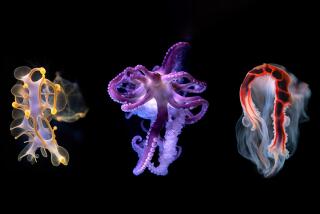Local astronomers share Kavli Prize for Kuiper Belt discoveries
Two Los Angeles-area scientists will share the 2012 Kavli Prize in Astrophysics for their work studying the Kuiper Belt in the outer solar system, the Kavli Foundation announced Thursday.
Michael Brown of Caltech and David Jewitt of UCLA were honored along with Jane Luu of MIT’s Lincoln Laboratory “for discovering and characterizing the Kuiper Belt and its largest members, work that led to a major advance in the understanding of the history of our planetary system,” according to the foundation.
David Jewitt and Luu are credited with spotting the first known object in the Kuiper Belt, an icy, disc-shaped territory beyond the orbit of Neptune. That discovery was made in 1992, after six years of observation. More than 1,000 Kuiper Belt objects have been identified since.
Scientists believe these so-called KBOs are remnants from the time when the solar system was formed about 4.6 billion years ago. As such, they may resemble the primordial stuff that became the basis for Earth and other planets, according to NASA. The comets that periodically orbit the sun are thought to make their home in the Kuiper Belt and the Oort Cloud beyond it.
The most famous resident of the Kuiper Belt is Pluto, which had been considered a planet until Brown came along. In 2005, he discovered Eris, probably the second-most-famous KBO. It was classified as a dwarf planet (its mass is much less than 1% the mass of Earth) despite being 27% bigger than Pluto.
That forced astronomers to reckon with an uncomfortable question: Did Pluto deserve to be called a planet? In 2006, a committee of the International Astronomical Union, which classifies and names celestial bodies, said that objects should be considered planets if they were round and orbited the sun. By that definition, Brown estimated that at least 53 objects in the solar system could qualify as planets.
Instead, the IAU voted to reclassify Pluto as a “dwarf planet.”
“Pluto’s out,” Brown said at the time, according to this Los Angeles Times story. “People are going to be unhappy, but it’s the right thing to do. This is a great moment in science.”
Brown went on to write a book called “How I Killed Pluto and Why it Had It Coming.”
Much about the Kuiper Belt remains a mystery to scientists, but that could change in a few years when NASA’s New Horizons spacecraft visits the far-away region. Launched in 2006, New Horizons is now more than halfway to Pluto and is scheduled to fly by the dwarf planet in 2015 before investigating other KBOs.
The Kavli Foundation also awarded a nanoscience prize to MIT’s Mildred Dresselhaus, “for her pioneering contributions to the study of phonons, electron-phonon interactions, and thermal transport in nanostructures” and a neuroscience prize to a trio of researchers “for elucidating basic neuronal mechanisms underlying perception and decision.”
The prizes will be awarded in Oslo, Norway, on Sept. 4. The prizes are awarded every other year.
Jewitt and Luu are having a great week -- on Tuesday, they won the 2012 Shaw Prize in Astronomy “for their discovery and characterization of trans-Neptunian bodies, an archaeological treasure dating back to the formation of the solar system and the long-sought source of short period comets.” That award will be presented in Hong Kong on Sept. 17.
Return to the Science Now blog.







